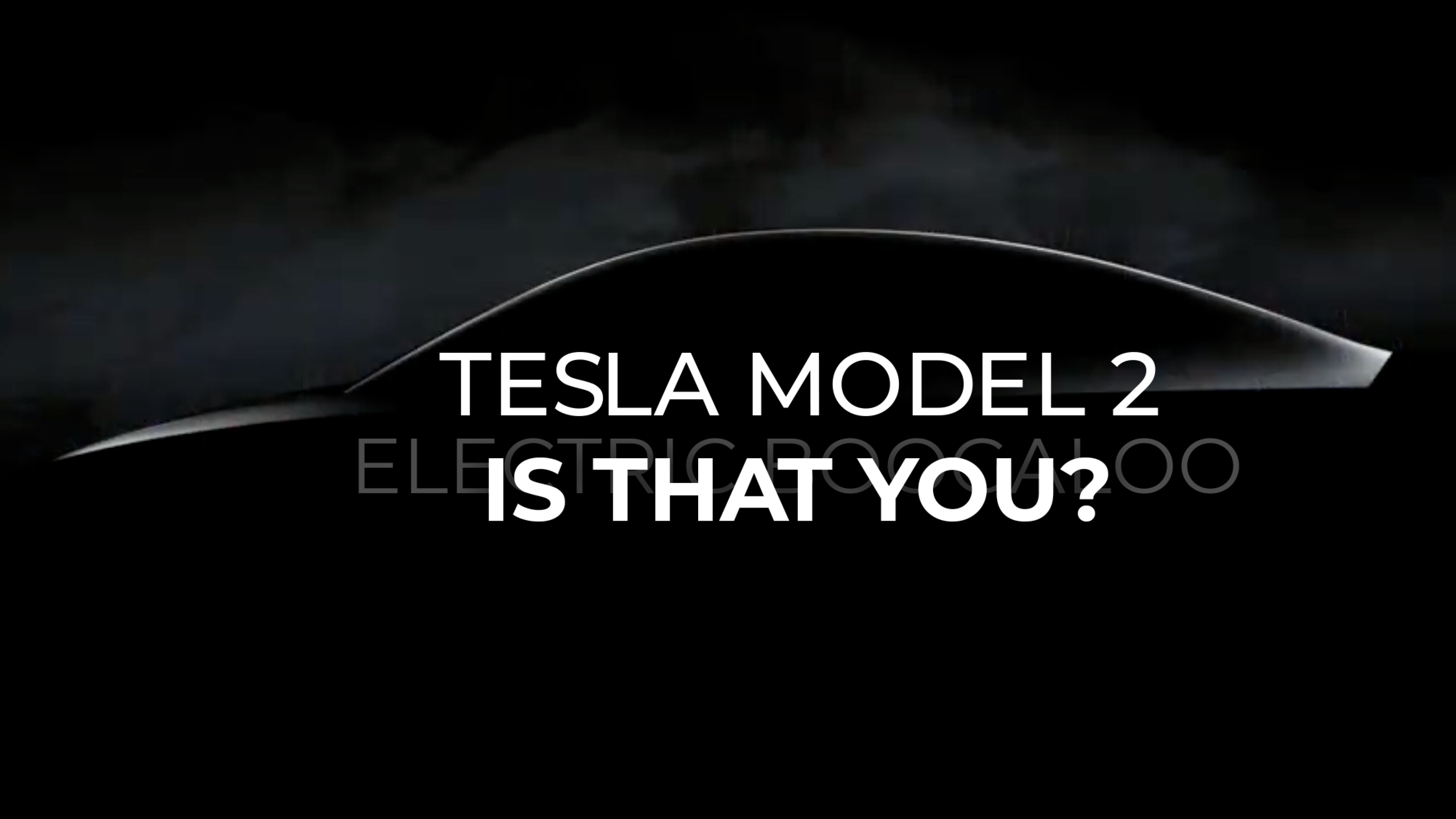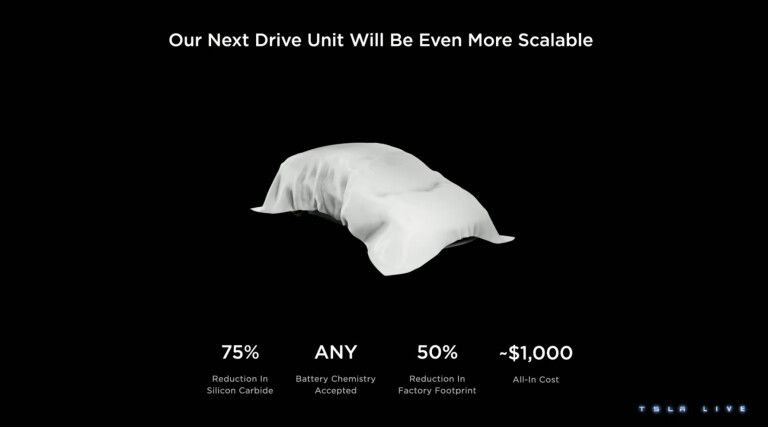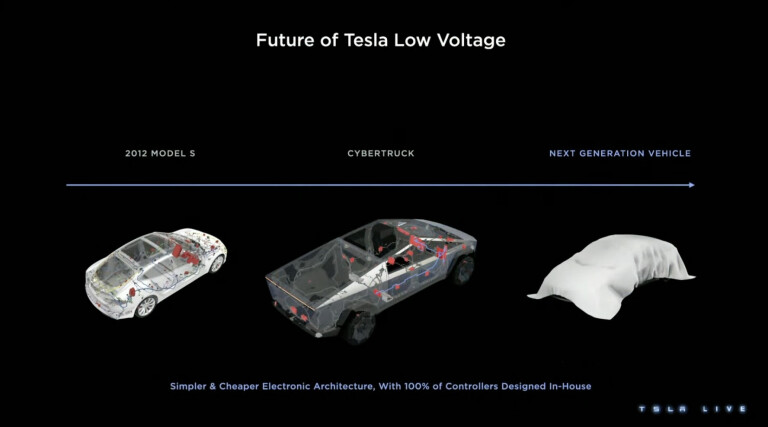
Tesla CEO Elon Musk has mysteriously teased the affordable ‘Model 2’ electric car at its annual shareholders meeting in Austin, Texas.
The shadowy image seemingly depicts a sedan body style with a sharp crease and rear cut-off, while the wind smoke in the background indicates that it, as per Tesla style, will be aerodynamically efficient.
“We are building and designing a new product. We're not sitting on our hands here. There are two new products I think you will be excited about,” Mr Musk said.
“Both design and manufacturing techniques are head and shoulders above anything else in industry.
“If I were to guess – an Elon guess, if you like – we will probably make in excess of five million units a year of these two models combined.”
Looks like a Model 3..?
While the teaser could also be interpreted as the silhouette of the purported 2024 Tesla Model 3 project ‘Highland’ update, Musk’s presentation suggests otherwise, having reiterated that this ‘next product’ would follow the Cybertruck electric ute (due later this year overseas).
But, we can never be too certain…
The Tesla ‘Model 2’ is expected to feature a new third-generation electric platform, a 53kWh lithium-iron-phosphate (LFP) battery pack, and optimised manufacturing to potentially cost less than $50,000 – if it lands in Australia.
Meanwhile, the other model mooted by Musk is likely an electric commercial and passenger people-mover van.
The American carmaker has also previously hinted at producing an electric bus and light truck in the future to expand its vehicle segment reach.
April 2023: Could the Model 2 look like this?
Based on what we've seen of the updated Model 3, we wonder if the upcoming Model 2 will look like this...
April 2023: Tesla previews three new EVs, including a bus and van
Tesla will widen its electric vehicle portfolio across a variety of segments, as it works to stay competitive in an increasingly crowded market. Full story below.
March 2023: Tesla previews new technology
Tesla has teased the hardware of its third-generation platform tipped to underpin a more affordable sub-$50,000 electric car.
Snapshot
- Next-gen affordable EV teased with low sedan-like shape, Tesla van also hinted
- Cheaper to produce and own with optimised internals
- Expects to sell 700 million units globally – almost double Model 3 and Y
While the full car (potentially called ‘Model 2’) wasn’t revealed at its Investor Day event, Tesla design boss Franz von Holzhausen said: “I think the track record proves that we can deliver the best cars.
"I’d love to really show you what I mean and unveil the next-gen car, but you’re going to trust me on that until a later date.”
Tesla's presentation slides seemingly depict a low-slung sedan or coupe silhouette, instead of previous rumours that the Model 2 would be a crossover SUV or hatchback.
It also teased a high-riding people-mover or van-like model.

The Model 2 is targeted to be 50 per cent cheaper to produce than the popular Model 3 sedan and Model Y SUV, cheaper to own than the base Model 3 rear-wheel drive over time, and can house any battery pack chemistry.
The popular EV-maker confirmed its next-gen model won’t contain any expensive and environmentally unsustainable rare earth materials in the permanent magnet electric motor. For reference, the current Model Y medium SUV uses around 520 grams of rare earths.
It will also adopt a smaller, lighter lithium-ion 48-volt auxiliary battery, which is claimed to last for the life of the vehicle, instead of the typical four-year lifespan of traditional lead-acid 12-volt units.
Production of the Tesla Model 2 will be streamlined to ensure it can scale up manufacturing volumes to meet strong demand, while reducing its factory footprint by 50 per cent.

The third-gen EV will adopt a sub-assembly approach that builds different car parts independently to allow more workers and robots to work on one area simultaneously, and then it will be assembled together to form a car.
This is instead of going to the body, disassembling select parts, and reassembling for the final product.
Inside, it’ll receive an optimised controller design and simplified wire harness to ensure mass production.
The company has been famous for slowly delivering newly-introduced cars – such as the Model 3 sedan, described as “production hell” in 2017, and facelifted Model S and Model X large EVs, which are expanding globally two years after its US launch.

The Tesla electric car will be made at its upcoming Mexico Gigafactory near Monterrey, but the carmaker said it will complement existing plants across the US, China and Germany, which will be upgraded to expand production outputs.
Tesla expects the Model 2 will sell 700 million units globally (with an unspecified timeframe) – in contrast to 380 million for the already popular Model 3 small sedan and Model Y medium SUV, 300 million for the upcoming Cybertruck pickup and teased Tesla van, and only 40 million for the high-end Model S liftback and Model X large SUV.
The company didn’t detail any previously purported updates to the existing Model 3 and Model Y, but it did say that it had reduced manufacturing costs by 30 per cent between 2018 and 2022.
Also missing during the event was any mention of the second-generation Tesla Roadster three-door electric coupe, which was unveiled in late 2017.
More EV stories to help you choose the best car for your needs
🚘 EV news, reviews, advice & guides
- ❓ Short & sweet: Your EV questions answered
- ⚡ New EVs: Everything coming to Australia
- 🥇 Australia's EVs with the longest driving range
- ⚖️ Best-value EVs by driving range
- 💰 How much do EVs cost in Australia?
- 😰 How much more expensive are EVs?
- ⚖️ Number crunching: Is it time to switch to an EV?
- ♻ Should you buy a used EV?
- 🛡️ Are EVs more expensive to insure?
- 🆚 Costs compared: Charging an EV vs fueling a car
- 📖 EV charging guide
- 👨🔧 EV servicing explained
- 🔋 EV battery types explained
- 🪫 When do EV batteries need replacing?
- 🆚 Hydrogen v EVs: What's best for Oz?



COMMENTS